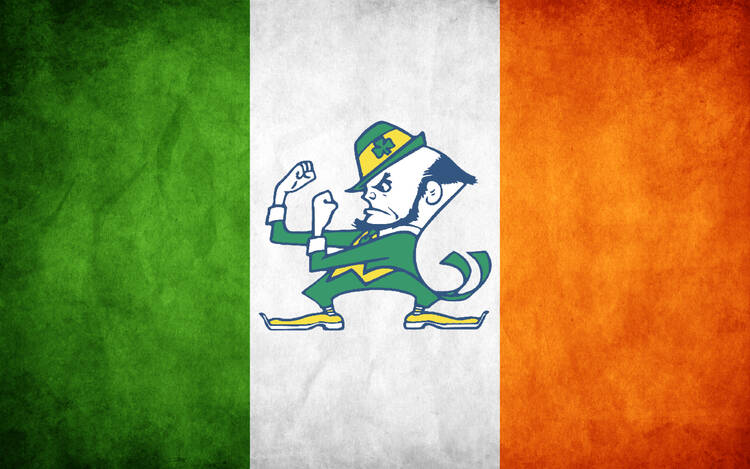On Saint Patrick’s Day, Americans like to say “everyone’s a little Irish.” The same sentiment can be shared for anyone who roots for The University of Notre Dame’s Fighting Irish football team. Perhaps the most storied program in the history of college football, with legions of fans globally, the team can even attract fans without ties to the school or Ireland.
The link between the school’s Irish identity and its football team will be rekindled tomorrow, Aug. 26, when the Fighting Irish return to Dublin’s Aviva Stadium for the first time since 2012 to play the Navy Midshipmen.
My father was told by a local that if Notre Dame ever came to play in Ireland, “the entire island would sink” as a result of the throngs of people that would come to watch.
My father happened to be at the first-ever American college football game on Irish soil, played between Boston College and Army in 1988, while he was studying abroad in Europe. He was told by a local that if Notre Dame ever came to play in Ireland, “the entire island would sink” as a result of the throngs of people that would come to watch.
While it doesn’t seem like the country is in danger of being engulfed by the Atlantic this weekend, an estimated 30,000 fans will descend on the Irish capital to watch the game, a testament to both Notre Dame’s impassioned fanbase and college football’s growth on the international stage. All over Dublin, fans report, ND signs can be found, in a land where Gaelic football, soccer, rugby and a host of other sports usually hold sway.
The mass camaraderie that the football team and its Irish heritage conjures is inspiring, but I also couldn’t help but think of all the division that the school’s Catholic identity has caused over the years. These divisions include debates over the selection of former President Barack Obama as their 2009 commencement speaker; students clashing over the appointment of ND Law alumnus Amy Coney Barrett to the Supreme Court; and, most recently, a rupture between pro-choice vs. pro-life groups on campus regarding the university’s speaker series on “reproductive justice.”
The debate over Notre Dame’s Catholic identity and principles is not all too dissimilar to those at my own alma mater, the College of the Holy Cross, whose “Crusader” mascot has been a hot-button issue among students and alumni alike. While the schism regarding the Crusader visual may be tumultuous and messy, both sides of the aisle have reveled in the recent success of the current four-time consecutive Patriot League Championship-winning Crusader football team.
I encourage those 30,000 strong in the Irish capital to remember the Irish saying “Ní neart go cur le chéile”—translated to “There is no strength without unity.”
Although spirited disagreements are a healthy way to spark intellectual engagement on any college campus, not just Notre Dame or Holy Cross, the “Fighting Irish” moniker got me thinking: What cause do the Fighting Irish fight for?
While the “Fighting Irish” name may not have a single origin story, it is largely believed that it stuck in part due to Éamon de Valera, an American-born freedom fighter and future Irish president who was instrumental in the formation of an independent Ireland.
De Valera came to the United States to stir hearts toward the Irish independence movement in 1919 after narrowly escaping execution by the British three years earlier. He spoke at Boston’s Fenway Park to a crowd double the size of the fanbase traveling to Dublin this weekend. He also came to South Bend, Ind., the same year, and his story planted a seed of admiration for the Irish cause on campus.
Just three years before coming to the States, de Valera was an instrumental figure in the 1916 Easter Rising, a historic moment in the Irish revolutionary movement, which saw fewer than 1,500 insurgents take on 16,000 British troops in the name of breaking free of English rule; the Irish knew they never stood a chance but still fought like hell.
While de Valera escaped execution (in part because, born in New York City, he had American citizenship), 16 Irish rebels were executed by the British for taking part in the insurrection. De Valera and other freedom fighters epitomized what the “Fighting Irish” stood for: these fighting Irishmen gave their lives to challenge British oppression and forge a united nation.
Long before the religious differences between Catholics and Protestants in “The Troubles” reared their ugly heads, Protestants like Jack White encouraged strikes in an attempt to save the lives of Catholic revolutionaries who were sentenced to death for their part in the Rising. This transcendental moment of religious cooperation in the name of a greater good reminded me of an unlikely union between two aforementioned figures at the center of religious differences at Notre Dame, when Amy Coney Barrett defended the construction of an Obama presidential library in his hometown of Chicago.
The connection between the cause for Irish independence and the nickname for Notre Dame’s sports teams serve as a twofold reminder. Yes, religious values are bound to cause differences of opinion on the scale of a college campus or an entire nation, but we must relish the moments where we can put those differences aside and pull for one common cause—and the Irish on the gridiron serve as an opportunity to do just that.
I encourage those 30,000 strong in the Irish capital to remember the Irish saying “Ní neart go cur le chéile”—translated to “There is no strength without unity.” It should serve as a touching moment to see ND football fans from all walks of life joined in sport and song on Saturday, united in the true Irish spirit of togetherness.








